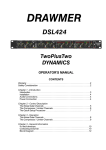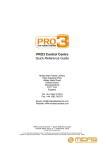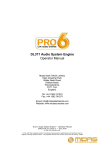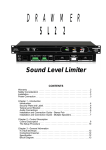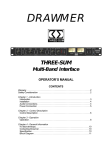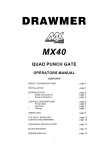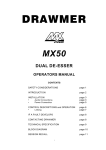Download Drawmer DSL424 Operator`s manual
Transcript
DRAWMER DSL424 TwoPlusTwo DYNAMICS OPERATOR’S MANUAL CONTENTS Warranty . . . . . . . . . . . . . . . . . . . . . . . . . . . . . . . . . . . . . . . . . . . . . . . . . . . . . . . . . . . 2 Safety Consideration . . . . . . . . . . . . . . . . . . . . . . . . . . . . . . . . . . . . . . . . . . . . . . . . 2 Chapter 1 - Introduction Introduction . . . . . . . . . . . . . . . . . . . . . . . . . . . . . . . . . . . . . . . . . . . . . . . . . . . . . . . 3 Installation . . . . . . . . . . . . . . . . . . . . . . . . . . . . . . . . . . . . . . . . . . . . . . . . . . . . . . . . 4 Audio Connections . . . . . . . . . . . . . . . . . . . . . . . . . . . . . . . . . . . . . . . . . . . . . . . . . 4 Power Connection . . . . . . . . . . . . . . . . . . . . . . . . . . . . . . . . . . . . . . . . . . . . . . . . . 4 Chapter 2 - Control Description The Noise Gate Channels . . . . . . . . . . . . . . . . . . . . . . . . . . . . . . . . . . . . . . . . . . . 5 The Compressor / Limiter Channels . . . . . . . . . . . . . . . . . . . . . . . . . . . . . . . . . . . 6 The Quick Setup Procedure . . . . . . . . . . . . . . . . . . . . . . . . . . . . . . . . . . . . . . . . . 7 Chapter 3 - Operation The Noise Gate Channels . . . . . . . . . . . . . . . . . . . . . . . . . . . . . . . . . . . . . . . . . . . 8 The Compressor / Limiter Channels . . . . . . . . . . . . . . . . . . . . . . . . . . . . . . . . . . . 9 Chapter 3 - General Information If a fault develops. . . . . . . . . . . . . . . . . . . . . . . . . . . . . . . . . . . . . . . . . . . . . . . . . . 10 Contacting Drawmer. . . . . . . . . . . . . . . . . . . . . . . . . . . . . . . . . . . . . . . . . . . . . . . 10 Specification . . . . . . . . . . . . . . . . . . . . . . . . . . . . . . . . . . . . . . . . . . . . . . . . . . . . . 11 Block Diagram . . . . . . . . . . . . . . . . . . . . . . . . . . . . . . . . . . . . . . . . . . . . . . . . . . . 12 Session Recall Sheet . . . . . . . . . . . . . . . . . . . . . . . . . . . . . . . . . . . . . . . . . . . . . . 13 COPYRIGHT This manual is copyrighted 8 2004 by Drawmer Electronics Ltd. With all rights reserved. Under copyright laws, no part of this publication may be reproduced, transmitted, stored in a retrieval system or translated into any language in any form by any means, mechanical, optical, electronic, recording, or otherwise, without the written permission of Drawmer Electronics Ltd. ONE YEAR LIMITED WARRANTY Drawmer Electronics Ltd., warrants the Drawmer DSL424 TwoPlusTwo Dynamics to conform substantially to the specifications of this manual for a period of one year from the original date of purchase when used in accordance with the specifications detailed in this manual. In the case of a valid warranty claim, your sole and exclusive remedy and Drawmer’s entire liability under any theory of liability will be to, at Drawmer’s discretion, repair or replace the product without charge, or, if not possible, to refund the purchase price to you. This warranty is not transferable. It applies only to the original purchaser of the product. For warranty service please call your local Drawmer dealer. Alternatively call Drawmer Electronics Ltd. at +44 (0)1709 527574. Then ship the defective product, with transportation and insurance charges pre-paid, to Drawmer Electronics Ltd., Coleman Street, Parkgate, Rotherham, S62 6EL UK. Write the RA number in large letters in a prominent position on the shipping box. Enclose your name, address, telephone number, copy of the original sales invoice and a detailed description of the problem. Drawmer will not accept responsibility for loss or damage during transit. This warranty is void if the product has been damaged by misuse, modification or unauthorised repair. THIS WARRANTY IS IN LIEU OF ALL WARRANTIES, WHETHER ORAL OR WRITTEN, EXPRESSED, IMPLIED OR STATUTORY. DRAWMER MAKES NO OTHER WARRANTY EITHER EXPRESS OR IMPLIED, INCLUDING, WITHOUT LIMITATION, ANY IMPLIED WARRANTIES OF MERCHANTABILITY, FITNESS FOR A PARTICULAR PURPOSE, OR NON-INFRINGEMENT. PURCHASER’S SOLE AND EXCLUSIVE REMEDY UNDER THIS WARRANTY SHALL BE REPAIR OR REPLACEMENT AS SPECIFIED HEREIN. IN NO EVENT WILL DRAWMER ELECTRONICS LTD. BE LIABLE FOR ANY DIRECT, INDIRECT, SPECIAL, INCIDENTAL OR CONSEQUENTIAL DAMAGES RESULTING FROM ANY DEFECT IN THE PRODUCT, INCLUDING LOST PROFITS, DAMAGE TO PROPERTY, AND, TO THE EXTENT PERMITTED BY LAW, DAMAGE FOR PERSONAL INJURY, EVEN IF DRAWMER HAS BEEN ADVISED OF THE POSSIBILITY OF SUCH DAMAGES. DRAWMER DSL424 Dual Channel Vacuum Tube Compressor SAFETY CONSIDERATIONS CAUTION - MAINS FUSE TO REDUCE THE RISK OF FIRE REPLACE THE MAINS FUSE ONLY WITH A FUSE THAT CONFORMS TO IEC127-2. 250 VOLT WORKING, TIME DELAY TYPE AND BODY SIZE OF 20mm x 5mm. THE MAINS INPUT FUSE MUST BE RATED AT 230V=T125mA and 115V=T250mA. CAUTION - MAINS CABLE DO NOT ATTEMPT TO CHANGE OR TAMPER WITH THE SUPPLIED MAINS CABLE. CAUTION - SERVICING DO NOT PERFORM ANY SERVICING. REFER ALL SERVICING TO QUALIFIED SERVICE PERSONNEL. WARNING TO REDUCE THE RISK OF FIRE OR ELECTRIC SHOCK DO NOT EXPOSE THIS EQUIPMENT TO RAIN OR MOISTURE. Some states and specific countries do not allow the exclusion of implied warranties or limitations on how long an implied warranty may last, so the above limitations may not apply to you. This warranty gives you specific legal rights. You may have additional rights that vary from state to state, and country to country. In the interests of product development, Drawmer reserve the right to modify or improve specifications of this product at any time, without prior notice. 2 DRAWMER DSL424 OPERATOR’S MANUAL CHAPTER 1 DRAWMER DSL424 TWOPLUSTWO DYNAMICS INTRODUCTION The DSL424 provides the engineer with a 1U four channel comprehensive toolbox capable of solving the most complex dynamic problems. Incorporated in the 1U package are two industry standard frequency conscious noise gates and two soft/hard knee compressors with variable threshold limiting. The channels may be front panel configured as four individual stand alone processors, a stereo linked pair of comp/limiters with a stereo linked pair of gates. Alternatively, any combination of processing can be achieved by rear panel patching. The DSL424 combines the gates of the DS404 with the compressor/limiters of the DL441 to provide a versatile 1U problem solver invaluable in applications where rack space is limited. Recognizing that there are many general applications which require equipment that is simple to operate, Drawmer have designed the noise gate stages of the DSL424 utilizing ‘Programme Adaptive’ circuitry. This makes the DSL424 ideally suited for use over a wide range of input signals, ranging from drums and other percussive instruments through to vocals, pianos and even complete mixes. The provision of variable Low-Pass and High-Pass Filters allows ‘without compromise’ frequency selective gating with a KEY LISTEN facility enabling monitoring of the filter setting. Each gate channel can be operated as HARD - offering ultra-fast response time, stable triggering and a specialized release contour which is ideally suited to percussive material or SOFT - a versatile Expander capable of handling vocals and sub mixes. Noise Gate • Variable High/Low Pass Filters for frequency triggering • Auto attack • Variable release • Switchable range with LED status • Selectable ‘Hard’ (drums etc.) or ‘Soft’ (vocals etc.) • 1/4 inch jack Key Inputs • Key Listen facility • Slave linking The compressor section features a highly developed, auto attack/release system which adapts itself to the programme material being processed and is equally effective on individual sounds or complex mixes. To maximise flexibility, each channel of the DSL424 is switchable between traditional ratio (hard knee) and soft-knee operation. Traditionally, soft-knee compressors are preferable for unobtrusive level control or for the control of finished mixes, whereas ratio type compressors are generally considered more successful in creative applications or where large amounts of gain reduction are required. By offering a choice of both modes, the DSL424 is capable of outstanding results in a very wide range of studio and live sound situations. The two channels may be operated independently or linked for true stereo operation. Also included in each channel of the DSL424 is a peak limiter which allows the user to set an absolute output signal level that will not be exceeded. If the peak limiter threshold is exceeded for more than a few milliseconds, additional gain reduction will be applied to reduce the overall signal level to within accepted limits without distortion. Once the peak has passed, the system gain will return to normal after a period of about one second. This facility is extremely valuable both in live sound applications, for driver protection, and in digital recording where an absolute maximum recording level exists. Furthermore, when deliberately overdriven, it can be used creatively to produce level “pumping” effects which can be useful on electric guitar or rock vocal sounds. Compressor/Limiter • Switchable Hard/Soft knee compression with variable threshold, ratio and output gain • Auto attack/release • Variable ‘zero overshoot’ transparent limiter • High resolution bargraph metering of gain reduction and input/output level • Stereo linking • Balanced +4dB XLR in/out DRAWMER DSL424 OPERATOR’S MANUAL 3 INSTALLATION The DSL424 is designed for standard 19" rack mounting and occupies 1U of rack space. Avoid mounting the unit directly above power amplifiers or power supplies that radiate significant amounts of heat and always connect the mains earth to the unit. Fibre or plastic washers may be used to prevent the front panel becoming marked by the mounting bolts. AUDIO CONNECTIONS The inputs and outputs are electronically balanced on conventionally wired XLRs (pin 1 screen, pin 2 hot, pin 3 cold and XLR shell is connected to chassis). The operating level is nominally +4dBu. Balanced use is recommended. • Interference: • Ground Loops: If the unit is to be used where it maybe exposed to If ground loop problems are encountered, never dishigh levels of disturbance such as found close to a TV connect the mains earth, but instead, try disconnector radio transmitter, we advise that the unit is operated ing the signal screen on one end of each of the cables in a balanced configuration. The screens of the signal connecting the outputs of the DSL424 to the patchbay. cables should be connected to the chassis connection If such measures are necessary, balanced operation on the XLR connector as opposed to connecting to is recommended. pin1. The DSL424 conforms to the EMC standards. POWER CONNECTION The unit will have been supplied with a power cable suitable for domestic power outlets in your country. For your own safety it is important that you use this cable. The unit should always be connected to the mains supply earth using this cable, and no other. If for some reason the unit is to be used at a mains input operating voltage which is different to that as supplied, the following procedure must be carried out : 1: Disconnect the unit from the mains. 2: Remove the two self-tapping screws that hold the voltage selection switch cover-plate onto the rear panel. 3: Remove the cover plate and slide the switch fully to its opposite end. 115V Setting 4: Rotate the cover plate one half turn, (180 degrees) and refit the two screws. 5: Replace with a correctly rated fuse for the selected operation voltage. 6: Re-connect to mains power source. Never disconnect the earth from the mains supply 4 230V Setting DRAWMER DSL424 OPERATOR’S MANUAL CHAPTER 2 CONTROL DESCRIPTION Noise Gate 1 Noise Gate 2 Compressor 1 Compressor 2 The Noise Gate Channels Both gate channels of the DSL424 are identical and may be used completely independently or linked for stereo channel operation. In the linked mode, only the left channel’s controls are functional and serve as master, though the channel bypass switches remain independent. When linked, the control signal is derived only from the programme material present at the input of the master channel. Threshold: Sets the level below which gating starts to take place and may be set in the range -70dB to +20dB. Display The famous Drawmer traffic light display shows gate status Gate Closed Hold Time Gate Open Release 10mS to 5S. Additionally, some envelope hold time is built into the system which varies with the release time. This prevents chatter when processing material with inconsistent decay characteristics and is quite invisible to the user. Range Determines how much gain reduction is applied when the gate is fully closed. A setting of -90dB effectively silences the signal completely, while the -20dB setting will still allow an attenuated version of the signal to pass through. We recommend this switch is left in the -90dB (out) position. For signals with a high levels of background noise, the very fact of closing down to -90dB can be disconcertingly noticeable. In such cases the -20dB switch setting can achieve better results. Note: This control is active on both channels, even in stereo linked operation. Key Listen / Gate / Bypass When this switch is set to Key Listen, the effect of the key filters on the programme material is heard at the output. In normal operation, the Gate position is selected; the filters only affect the way the DSL424 responds to the incoming programme material - they do not have any direct effect on the output signal. The Bypass position routes the input signal to the output with no processing. Note: It is possible to leave the switch in the Key Listen position in order to use the DSL424 simply as a filter rather than a gate. DRAWMER DSL424 OPERATOR’S MANUAL 5 The Noise Gate Channels cont... L.F. 25Hz - 10kHz The Low Frequency filter works by severely attenuating frequencies below the cut-off frequency selected. H.F. 200Hz - 35kHz The High Frequency filter attenuates frequencies above the selected cut-off value. In other words, when both filters are set, it is the range between the two settings that is allowed to pass. Ext/Int In the INT position, this switch causes the gate to respond to the dynamics of the signal being processed. In the EXT position, an external audio signal fed to the key input is used to control the gate, making it possible to gate one sound using another, independent signal. Gating Hard/Soft This button selects between the Hard and Soft modes of operation. In the Hard mode, the DSL424 behaves as a fast, conventional gate while in Soft mode, it performs as a programme adaptive expander. Hard mode is signified by a red status LED while the Soft mode is identified by a yellow LED. If two channels are linked, the mode is determined by the master (left) channel and the Hard/Soft LEDs on the slave channel will extinguish. Master Link When the link button is depressed, the gate 2 channel on the right is controlled by the gate 1 left hand channel. In linked mode, the red status LED beneath the Slave Link switch will be illuminated, and both the yellow and red HARD/SOFT LEDs of the slave channel will be extinguished. This assists to show that the only controls of the slave channel that still function are the Key Listen / Gate / Bypass switch and the Range switch. The Compressor/Limiter Channels Both compressor channels of the DSL424 are identical and may be used completely independently or linked for stereo operation. In the linked mode, only the left hand channel (compressor 1) controls are functional and serve as master controls, though the channel bypass switches remain independent. In linked mode, the compressor/limiters and peak limiters of the two linked channels track together to avoid the inevitable image shifting that occurs if the two channels of a stereo signal are treated independently. Compressor Threshold Determines the input level above which gain reduction will be applied and may be set in the range -40 to +20dB. When Soft Knee compression is selected, the onset of compression is progressive over an input range of approximately 15dB, above which level conventional ratio compression is applied. For this reason, the signal level may appear to fall when the compressor is switched from Hard to Soft Knee operation and some readjustment of the threshold setting may be required. Knee Hard/Soft Selects Hard or Soft Knee operation. In general, the Soft Knee mode provides the least obtrusive gain control and is often the preferred setting when treating finished mixes. 6 DRAWMER DSL424 OPERATOR’S MANUAL Ratio Sets the final compression ratio that will be applied once the threshold level is exceeded. The ratio may be continuously adjusted from 1.2:1 to infinity:1 allowing the possibility of true hard limiting. Gain During compression, the signal is attenuated depending on the dynamics of the signal. As a result, gain may need to be applied in order to produce the desired output level. The GAIN control has a range of -20dB to +20dB. If the limiter is in operation, only increase GAIN until the limiter operates on signal peaks. Any further GAIN will just cause excessive limiting, thus reducing the effect of the compressor. Bypass This switch will disable the functioning of the Compressor section and the Peak Limiter. If operating in Stereo Linked mode, both linked compressor channels will be bypassed simultaneously. Gain Reduction Meter An eight segment LED bargraph meter continuously monitors the gain reduction applied by the compressor/limiter over the range 0 to 30dB. Output Level Meter This is a 5-segment LED bargraph level meter that monitors the level of the output signal over the range -10dB to +10dB. Peak Limiter Level This control sets an absolute limit to the level that the output signal will not be permitted to exceed. This limiter is very fast acting enabling it to control any peaks without audible distortion. If the output signal is so high as to cause the limiter to operate for more than 20mS, the system gain is automatically reduced to bring the signal back within range. The system gain is then returned to normal over a period of approximately one second. The compressor Gain control should be used to ensure that the peak limiter operates only rarely if at all if the limiter is to be used purely for peak protection. Alternatively, the unit may be deliberately driven into limiting to produce creative effects. THE QUICK SETUP PROCEDURE Quickly Setup the Gate • Select the Key trigger source. • Select Key Listen, and trim down to the desired frequency for triggering the Gate using the HFand LF Key filters. • Select the desired amount of reduction using Range. Normally fully counter clockwise. • Set the Attack, Hold. Decay and Range controls. For a programme with long legato release, then Release will also need to be long. Eg. Piano with reverb. For material with much low frequency content, the Attack will need to be quite slow, unless a ‘click’ is desired. • Using the Traffic Light LED display, rotate the Threshold until some gating activity can be seen. As a rule, the Threshold will need to be about 3dB below the average input level to both see and hear the dynamic processing. Quickly Setup the Compressor/Limiter • Select Hard Knee if compressing percussive tracks and Soft Knee for vocals. • Ensure the Limiter control is fully clockwise. • From the programme material, set the Ratio. The ratio setting depends on how firmly the signal dynamics need controlling; as a rule, higher ratios provide a higher degree of control but also tend to be more audibly apparent in operation when high levels of gain reduction are required. In general, we suggest less than 2.5:1 for vocals, less for full mixes, and more for dynamic single tracks. • Using the VU meter and the Compressor Gain Reduction (GR) meter, rotate the Threshold until some GR activity can be seen. As a rule, the Threshold will need to be about 6dB to 10dB below the average input level to both see, and hear, much change. • Adjust the Gain to give the desired amount of level on the VU Meter. • Adjust the Peak Limiter so that the limiter led only lights on signal extreme peaks. DRAWMER DSL424 OPERATOR’S MANUAL 7 CHAPTER 3 OPERATION The Noise Gate Channels The unit should be connected in-line with the signal to be processed via suitable insert points. Ensure, where possible, that the insert send and return level on your console approximately matches the operating level of the DSL424. For mono use, each channel may be considered as being completely independent and set up accordingly. For use with stereo signals, all setting up is then done using the noise gate 1 (left) channel's controls. For percussive material such as drums, fast synthesised sounds or percussive bass guitar, the Hard mode of operation will give the fastest response. However, with material having a slower attack, the Hard setting may produce transient clicks at the beginning of sounds in which case the Soft setting may produce better results. Initially, the Low filter should be set fully anti-clockwise while the High filter should be set fully clockwise. This will allow the full audio spectrum of the input programme to be monitored by the side-chain control circuitry. Set the Range control to -90dB and the output selector switch to Normal. With the release control set at its mid-way position, Range set to -90dB and with suitable programme material fed into the DSL424, increase the Threshold level from its anticlockwise position until the gate starts to operate. This will be indicated by the activity of the traffic light LEDs and you should also hear the effect on the outputs signal in that pauses in the programme will now be silent. If the threshold setting is too high, the gate will start to cut out wanted pieces of programme so you should adjust it to as low a setting as possible consistent with the effective removal of low level noise. If the ends of sounds are obviously being truncated, then a longer release time may help. On the other hand, if unwanted noise is audible after the wanted sound has ended, a shorter release time may well be more appropriate. There are circumstances when the programme material is corrupted not only by unwanted random noise, but by some other sound. For example, in a multi-miked drum kit setup, some hi-hat will inevitably leak into the snare mic, some snare drum into the kick drum mic and so on. Equally, when recording on location, you may experience problems due to wind or traffic noise or close-by conversation. If the unwanted noise is different in pitch to the wanted sound, 8 it is often possible, by using the Key Listen facility, to use the filters to 'tune' into the wanted sound while excluding as much of the unwanted sound as possible. Used carefully, these filters can significantly increase the gate's immunity to false triggering. LINKED OPERATION It is important to note that when linked, the control signal is derived entirely from the noise gate 1 channel. This means that stereo signals where one channel differs significantly from another may fare better if the channels are not linked. On the other hand, this mode of linking is very powerful in synchronizing the start and finish of sounds, a typical application being to tighten up backing vocals. If one singer tends to finish notes on time while the other hangs on too long, the correct version can be used as the master to ensure that both finish at the same time. Similarly, one sound can be used to gate another without having to resort to patching in an external key signal. An example might be to gate a low frequency tone from a bass drum signal and then add this gated tone to the drum sound to add depth. DIFFICULT MATERIAL As with any other gate, noise can only be removed during pauses in the wanted material. If the noise contamination is serious enough to be evident even during moderately loud programme material, then simple gating will do little to help. Indeed, the very fact that the gate produces nearperfect silence during pauses can make the noise content of the programme material seem even worse. In marginal cases, setting the range control to -20dB rather than 90dB will adequately reduce the noise during pauses but not sufficiently to cause an unacceptably dramatic change in noise level as the gate opens and closes. More sophisticated processors such as the Drawmer DF330 are better able to cope with excessive noise as they adaptively filter the programme so as to mask the noise during low level passages or where there is little high frequency content present to mask it. However, the key filters in the DSL424 may also be used to good effect, particularly in situations where the wanted signal does not occupy the full audio spectrum. DRAWMER DSL424 OPERATOR’S MANUAL Taking the example of the electric guitar, this produces little below 100Hz or above 3kHz so setting one channel of the DSL424 to Key Listen mode will enable you to use the filters to exclude much of the amplifier hum at the low end and hiss at the top end while having little effect on the sound of the guitar. Surprisingly, the same is true of the acoustic guitar; (even a bright-sounding steel-strung model), and the filters can be used to reduce the effect of string squeak or the player's breathing. Other applications of the filter section include shaping DI'd electric guitar sounds to remove unpleasant overtones and to simultaneously clean and warm up digital synthesizer sounds. While we should always endeavour to get the highest quality of programme material at source, every engineer is occasionally confronted with inferior material from sources beyond his control. Conventional equalisers seldom have a sharp enough response to duplicate the function of the Key filters which invariably results in the wanted material being filtered as well as the unwanted noise. Once a signal has been filtered in this way, it may also be processed by the second channel of the DSL424 to apply conventional gating. The Compressor / Limiter Channels The unit should be connected in-line with the signal to be processed via suitable insert points. For mono use, each channel may be considered as being completely independent and set up accordingly. For use with stereo signals such as complete mixes or submixes, the channels should be switched to Stereo Link mode and all setting up done using the compressor 1 (left compressor) channel controls. Compressing during a mix does increase the subjective level of tape and other background noises during pauses and quiet passages as maximum gain is applied when the signal level is minimum. For this reason, it is unwise to use more compression than is strictly necessary. However, using the DSL424 the signal can be patched through the gate, either before or after the compressor, to remove any unrequired sounds. Setting up is simplified by the auto attack and release system which continually optimises the attack and release times to suit the dynamics of the material being processed. The ratio setting depends on how firmly the signal dynamics need controlling; as a rule, higher ratios provide a higher degree of control but also tend to be more audibly apparent in operation when high levels of gain reduction are required. In general, a higher compression ratio may be used when in Soft Knee mode without compromising the subjective sound quality. Finally, the Gain control may be set to provide the required output level using the level meter as a guide. Avoid running at very high output levels as this reduces the available amount of signal headroom and could lead to distortion in extreme cases. Once the gain is correct, the Peak limiter Level control should be adjusted so that the limiter LED only lights briefly on extreme signal peaks. Alternatively, the Peak limiter Level may first be set to the desired value and then the compressor Gain control adjusted to ensure minimum limiter activity. Having selected Hard or Soft Knee and set a suitable Ratio, setting up is simply a matter of adjusting the Threshold control until the desired amount of gain reduction occurs. This is judged partly by ear and partly by observing the gain reduction meter. Normally a maximum gain reduction of between 8dB and 12dB will be adequate. If more gain reduction appears necessary, it is worth considering applying a conservative degree of compression during recording and then further compression while mixing. The Peak limiter has no bypass control, but turning the Level control fully clockwise will effectively prevent the limiter from operating. Compressors are often accused of dulling the sound being processed, but the auto circuitry in the DSL424 has been designed to allow transient sounds to pass through cleanly, thus maintaining the clarity and transparency of the original source. Soft Knee operation is usually preferable when unobtrusive gain control is required. DRAWMER DSL424 OPERATOR’S MANUAL 9 CHAPTER 4 GENERAL INFORMATION It is the responsibility of the installer to ensure that the continuous power rating of the speakers is not exceeded, as Drawmer Electronics Ltd will not accept any responsibitlity for speaker damage caused by incorrect settings. IF A FAULT DEVELOPS CONTACTING DRAWMER For warranty service please call Drawmer Electronics Ltd. or their nearest authorised service facility, giving full details of the difficulty. Drawmer Electronics Ltd., will be pleased to answer all application questions to enhance your usage of this equipment. Please address correspondence to: A list of all main dealers can be found on the Drawmer webpages. On receipt of this information, service or shipping instructions will be forwarded to you. No equipment should be returned under the warranty without prior consent from Drawmer or their authorised representative. For service claims under the warranty agreement a service Returns Authorisation (RA) number will be issued. Write this RA number in large letters in a prominent position on the shipping box. Enclose your name, address, telephone number, copy of the original sales invoice and a detailed description of the problem. Authorised returns should be prepaid and must be insured. All Drawmer products are packaged in specially designed containers for protection. If the unit is to be returned, the original container must be used. If this container is not available, then the equipment should be packaged in substantial shock-proof material, capable of withstanding the handling for the transit. 10 Drawmer (Technical Help line) Coleman Street Parkgate Rotherham S62 6EL UK Alternatively contact us by E-mail on : [email protected] Further information on all Drawmer dealers, Authorised service departments and other contact information can be obtained from our web pages on: http://www.drawmer.com DRAWMER DSL424 OPERATOR’S MANUAL DSL424 TWOPLUSTWO DYNAMICS DATA SPECIFICATION NOISE GATE CHANNELS COMPRESSOR / LIMITER CHANNELS INPUT INPUT Input Impedance 20k Ohms (Balanced) Max Input level +21dBuB (+17dB ref. +4dBu) Input Impedance Key Input Impedance 20k Ohms (Balanced) 20k Ohms (Unbalanced) Max Input level Max Key Input Level +21dBu +21dBu OUTPUT Output Impedance 50 Ohms (Balanced) Output Level Bandwidth +21dBu <10Hz to 22kHz -1dB Floor Level -90dB, (or -20dB) OUTPUT Output Impedance 50 Ohms (Balanced) Output Level Bandwidth +20dBu <12Hz to 35kHz -1dB Crosstalk @10kHz Better than -80dB @20kHz Better than -75dB Output Balance Better than 40dB 20Hz to 10kHz Noise at Unity Gain ref. +4dBu Noise Wideband 22Hz-22kHz CCIR AV -91dB -97dB RMS -89dB -96dB IEC A Q-Pk CCIR -97dB -100dB -86dB -99dB Wideband 22Hz-22kHz CCIR IEC A Q-Pk CCIR AV -90dB -98dB -99dB -100dB RMS -89dB -96dB -97dB -88dB -98dB Distortion Distortion 100Hz Gate Open with +4dB Input <0.04% 1kHz 10kHz <0.04% <0.04% 100Hz Unity Gain, +4dB Input Power Requirements 115Volt or 230Volt at 50-60Hz, 15VA Fuse Type CONFORMS TO IEC127-2. Fuse Rating 230V=T250mA, 115V=T125mA. Case Size 482mm (w) x 44mm (h) x 190mm (d) Weight (incl packaging) 3.7 Kgs DRAWMER DSL424 OPERATOR’S MANUAL <0.02% 1kHz 10kHz <0.015% <0.035% 11 BLOCK DIAGRAM DSL424 ver 01 B 29/06/04 12 DRAWMER DSL424 OPERATOR’S MANUAL DRAWMER DSL424 OPERATOR’S MANUAL 13 dB 10 1K 3K5 1K 2K 200 500 500 250 INT Hz 6 :1 3 1 RATIO 2 20 10 20 GAIN dB 0 BYPASS 20 10 OUTPUT LEVEL 5 0 5 10 10 dB 0 5 LEVEL dB 10 DRAWMER ELECTRONICS LTD ~ Coleman Street Rotherham ~ S. Yorkshire ~ UK © COPYRIGHT DRAWMER ELECTRONICS LTD 2004 1S 16 LINK 15 Master LINK Master dB 10 25 6 1.2 2 4 HARD SOFT Session No. 2 200 :1 3 5 20 10 1 dB 10 RATIO Tape Location Artist Date 3K5 1K 2K Hz HARD SOFT 35K 0 5K 10 10K GATING 2K 20 10 GAIN dB 0 dB 0 5 LEVEL dB 10 PEAK 16 15 1S ON OFF DSL424 TwoPlusTwo DYNAMICS DRAWMER 90dB 20dB 5S 4S GATE BYPASS RANGE 2S KEY LISTEN OUTPUT RELEASE 10mS .1S 60 50 40 70 20 30 THRESH 20 10 BYPASS 20 10 OUTPUT LEVEL 5 0 5 10 L.F. FILTER H.F. Hz 1K INT 500 500 250 COMPRESSOR 2 50 150 EXT KEY SOURCE 100 1.5 KNEE 30 20 40 THRESH 20 10 0 GAIN REDUCTION 30 20 15 10 90dB 20dB 5S 4S GATE RANGE 2S BYPASS OUTPUT KEY LISTEN RELEASE 10mS PEAK 60 .1S 50 40 70 20 30 THRESH 20 10 DSL424 5 dB 10 HARD SOFT 35K 0 5K 10 10K GATING 2K Session Recall HARD SOFT 1.2 2 4 COMPRESSOR 1 L.F. FILTER H.F. Hz 150 1.5 KNEE 30 20 40 THRESH 20 10 0 GAIN REDUCTION 30 20 15 10 25 100 50 EXT KEY SOURCE













